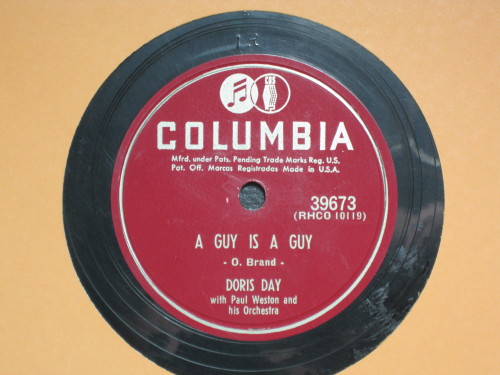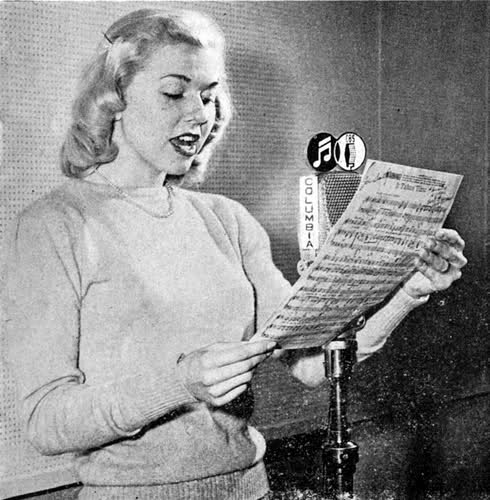
Song: A Guy Is A Guy / Who Who Who
Artist: Doris Day with Paul Weston and his Orchestra
Record Label: Columbia Records 39673
Recorded: February 7, 1952
Released: March 1952
Here’s something a bit different. Mafia II has a very expansive soundtrack, but some didn’t manage to make the final cut into the game.
After Vito Scaletta gets into an armed scuffle with some would-be muggers, he attempts to get away from a cop who asks for his nonexistent weapons permit. He shakes off the police who received his physical description by ducking into a Dipton Apparel store where this song is playing.
A few minutes later Scaletta nonchalantly walks out with a new suit like a “good boy should”.
This song has a surprisingly long and colorful history. Originally, it was a British song published in 1719 called “I Went to the Alehouse (A Knave is a Knave)”. The lyrics got bawdier when soldiers in WWII began singing “A Gob Is a Slob”.
Oscar Brand managed to clean up the lyrics, the result having the smallest hint of impropriety. The addition of marriage in the lyrics removed any scent of scandal complete with themes from both Mendelssohn’s “Wedding March” and Wagner’s “Bridal Chorus”.
Ella Fitzgerald recorded a version with Sy Oliver’s Orchestra on February 25, 1952, though Day’s version would reach the top of the charts.
I have some sources saying that the Norman Luboff Choir provided the backing vocals, but it’s difficult to verify especially since they are not on the label itself.

Before Doris Day was a star of radio, film, and TV, she was born Doris Kappelhoff in Cincinnati, Ohio. She had two older brothers, with her father Frederick teaching piano and violin and her mother Alma Sophia. The family, however, was troubled with the parents divorcing when Doris was 10 years old.
She aspired to be a dancer and formed a duo with Jerry Doherty in local productions. However a car accident in October of 1937 would leave her convalescing, singing along with the radio. She greatly admired the big bands, but zeroed in on the voice of Ella Fitzgerald and her subtle nuances.
Her mother decided to give Doris singing lessons with Grace Raine. During her lessons, Doris got her first job on WLW radio where she caught the attention of bandleader Barney Rapp. She became his girl vocalist for the band and earned her stage name “Doris Day” after her rendition of “Day After Day”. She would go on to work with other bandleaders Jimmy James, Bob Crosby, and Les Brown.
Day had her first hit in Les Brown’s Orchestra with “Sentimental Journey” in 1945 and continued with six more hits, by the time she left the band in August 1946.
She toured with Bob Hope’s weekly radio program and starred in the 1948 film, Romance on the High Seas in a breakout role with a new hit record “It’s Magic”.
She would continue to star in nearly 40 films including Pillow Talk, The Man Who Knew Too Much, Love Me or Leave Me, That Touch of Mink, and Move Over Darling. In an exclusive contract with Columbia Records she would make over 650 recordings including her other signature song “Que Sera, Sera” also known as “Whatever Will Be, Will Be”.

By this time, Paul Weston would be chief music director and arranger at Columbia Records, following a long stint at Capitol Records. Within the same month of this recording, Paul Weston would be married to singer and longtime colleague Jo Stafford on February 26, 1952.
He had previously worked with Day and Danny Thomas recording for the 1951 Gus Kahn biographical film I’ll See You in My Dreams. Weston would continue to arrange for Day on other singles including “On Moonlight Bay”, “Shanghai”, and “Candy Lips”.
Coincidentally, he co-wrote a song similar to Doris Day’s namesake, “Day by Day” which Doris recorded with Les Brown’s band in 1946. This song would become the basis of an album using Columbia’s new long-playing technology, Day By Day. Instead of sporadic singles, songs could be played in succession, intentionally creating an overarching mood.
The album would reach the Top Ten and of course included a new recording of “Day by Day”.
shipsindanight liked this
rapturerecords posted this
